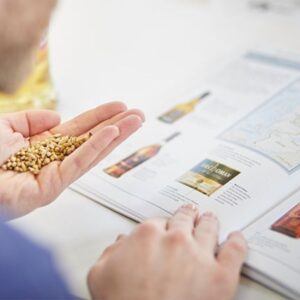Rum is much more than just a tropical spirit.
It embodies centuries of history, an incredible cultural diversity, and a rich aromatic profile that captivates both amateurs and experts around the world.
From Jamaica to Martinique, Cuba to Venezuela, and even Réunion Island, every rum tells a unique story—shaped by its terroir, raw materials, and the craftsmanship of its producers.
But with so much variety, how can we navigate this world?
How do you truly understand and taste rum with precision?
What production methods should you know to speak confidently about it?
In this article, you’ll learn everything you need to know about rum—from its origins and production techniques to major global styles and professional tasting methods—based on the content taught in the WSET Spirits qualifications.
You’ll discover:
- The origins and specificities of rum
- The key stages of its production
- The main rum styles around the world
- Professional tasting techniques
- And why studying rum with the WSET at Weeno gives you a major edge
Want to take your rum knowledge further?
👉 Check out our internationally recognized WSET Spirits courses online with Weeno.
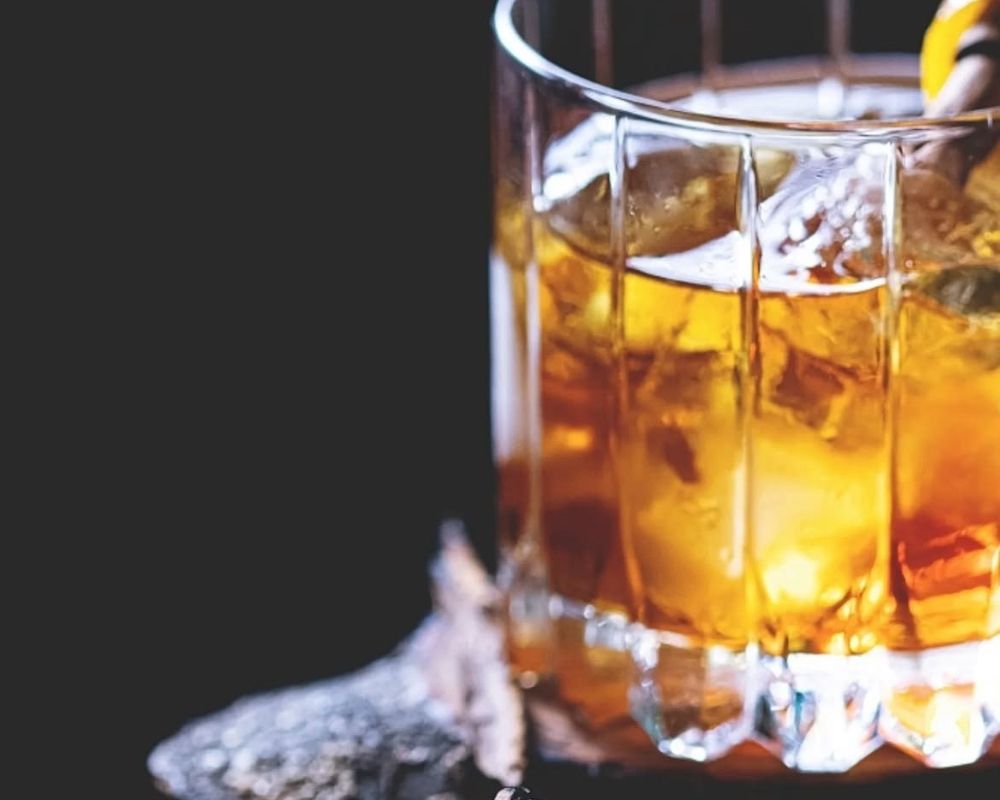
1. What is Rum?
Rum is a distilled spirit made by fermenting and distilling products derived from sugarcane.
It’s a staple spirit of tropical regions—particularly the Caribbean, Latin America, and certain parts of Africa and Asia.
There are two main types of raw materials used to produce rum, and they significantly influence its style:
1.1. Molasses-Based Rum
Molasses is a by-product of the sugar production process.
After sugar has been extracted from sugarcane juice, the leftover molasses—rich in residual sugars—is fermented and then distilled.
- Main producing regions: Jamaica, Barbados, Cuba, Trinidad, Venezuela, Guyana
- Tasting profile: Often rounder and sweeter, with notes of caramel, banana, spices, and vanilla
- Style: Widespread internationally and commonly used in commercial rums and cocktails
1.2. Agricole Rum
Agricole rum is made from fresh sugarcane juice (also called vesou).
This more artisanal method produces rums with a fresher, more vegetal and complex profile.
- Main producing regions: Martinique (AOC), Guadeloupe, Réunion Island, Madeira
- Tasting profile: Herbaceous, fresh, with aromas of fresh cane, citrus, and flowers
- Unique feature: In Martinique, it’s protected by an Appellation d’Origine Contrôlée (AOC), recognized for its high quality
1.3. Official Rum Categories According to WSET
The WSET Spirits qualifications teach that rum can also be categorized by style:
- White Rum: Unaged and light, perfect for cocktails
- Gold/Amber Rum: Aged for a few months to a few years, with woody and vanilla notes
- Aged Rum: Aged for several years, complex, and best enjoyed neat
- Overproof Rum: High-ABV rum (often over 57%), used in mixology
Each style is shaped by:
- The aging duration
- The type of cask used (often ex-bourbon or French oak)
- The climate conditions during aging (warmer climates = faster aging)
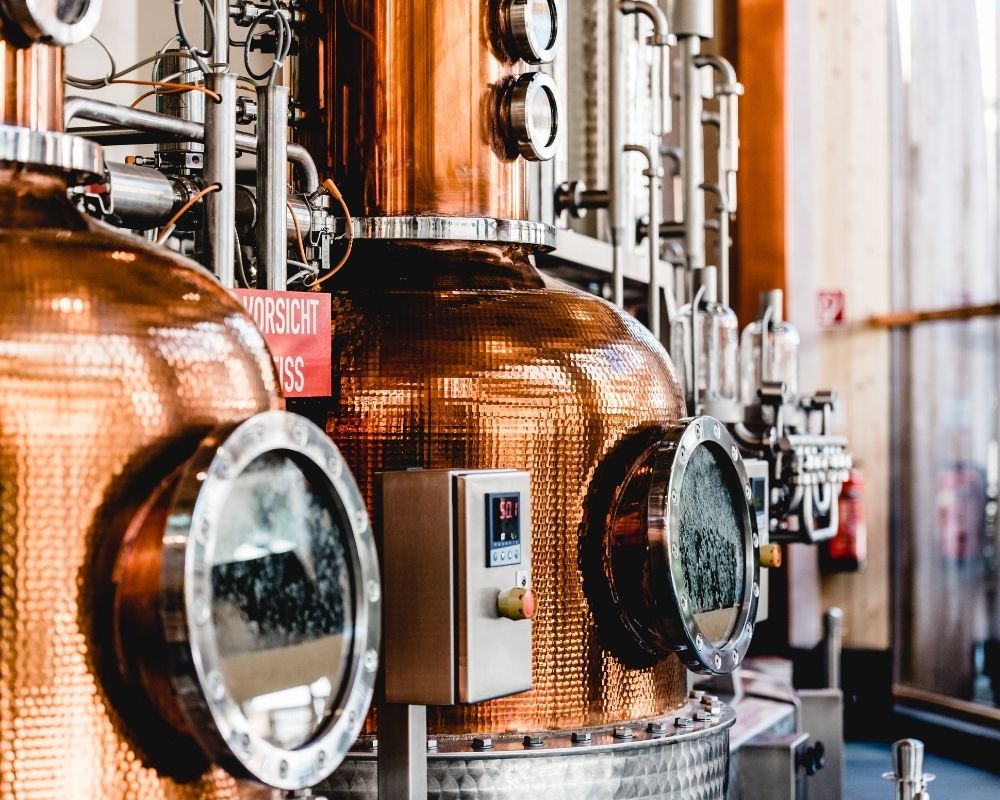
2. Key Stages in Rum Production
Like any distilled spirit, rum owes its aromatic richness to a series of technical and carefully calibrated steps during its production process.
WSET Spirits qualifications emphasize how each decision made by the producer directly impacts the final product’s style, quality, and complexity.
👉 By the way, check out our recent article about our brand-new WSET Level 3 in Spirits course now available at Weeno!
Here’s a breakdown of the key stages:
2.1. Raw Material: Molasses or Fresh Cane Juice
As mentioned earlier, the choice between molasses and fresh cane juice is fundamental:
- Molasses is more stable and allows for large-scale, industrial production.
- Fresh cane juice, which is more fragile, requires rapid distillation after extraction. It’s often used for artisanal rums that express more aromatic complexity.
2.2. Fermentation: Developing Primary Aromas
Fermentation transforms sugars into alcohol with the help of yeast.
- Duration: From a few hours to several days
- Temperature: Varies depending on the desired style
- Yeast: Can be wild or selected strains
Impact on rum:
- Short fermentations result in lighter, floral rums ideal for mixing
- Long fermentations develop complex esters with tropical fruit, leather, and spice notes—especially in Jamaica
2.3. Distillation: Concentrating Aromas
WSET distinguishes two main distillation methods for rum:
- Pot Still (Batch Distillation):
Produces rich and full-bodied rums
Commonly used for agricole or premium rums
Delivers bold aromas and a rounded texture - Column Still (Continuous Distillation):
Enables high-volume, continuous distillation
Produces lighter, cleaner rums
Often used for industrial or cocktail rums
Each method impacts the rum’s final weight, intensity, and aromatic range.
2.4. Aging: Building Complexity
After distillation, rum may be:
- Bottled young, particularly for white rum
- Aged in oak barrels to develop secondary and tertiary aromas
Key factors in aging:
- Type of cask: Ex-bourbon barrels, French oak, wine-seasoned casks, etc.
- Climate: Warmer climates accelerate aging, intensifying flavor and color
Aged rums offer notes of vanilla, caramel, spices, tobacco, wood, and dried fruit.
2.5. Blending and Bottling
Before being released to the market, rum may undergo:
- Blending: Combining different batches, ages, or styles to achieve a consistent profile
- Reduction: Lowering the alcohol content with pure water
- Coloring: Some industrial rums use caramel coloring to standardize appearance (a common but controversial practice)
WSET Focus:
WSET training emphasizes how producers shape every element of the rum’s identity:
- Raw material
- Fermentation time and method
- Distillation type
- Aging duration and barrel choice
Together, these decisions define the rum’s style, quality, and character.
👉 Explore our WSET Spirits courses in Paris and Marseille to dive deeper into rum production and tasting.

3. The Major Styles of Rum Around the World
Although rum is produced in many regions, it can generally be grouped into major styles shaped by colonial history, local traditions, and production methods.
WSET Spirits courses teach you how to recognize these styles and their specific characteristics.
3.1. French-Style Rum: Rhum Agricole
- Origin: French Caribbean islands (Martinique, Guadeloupe, Marie-Galante), Réunion Island, Haiti.
- Raw Material: Fresh sugarcane juice.
- Method: Long fermentation, column distillation.
- Characteristics:
- Highly expressive, fresh, vegetal, and floral rums.
- Flavors of fresh cane juice, cut grass, and white pepper.
- Appellations:
- AOC Rhum Agricole Martinique: The only appellation d’origine contrôlée (AOC) for rum.
- Different categories: white rum, “élevé sous bois” (aged 12–18 months), “rhum vieux” (aged more than 3 years).
3.2. English-Style Rum: Rich and Full-Bodied
- Origin: Jamaica, Barbados, Trinidad, Guyana.
- Raw Material: Molasses.
- Method: Long fermentation, pot still or mixed distillation.
- Characteristics:
- Heavy rums rich in esters.
- Intense aromas of ripe tropical fruit, leather, banana, and spices.
- Regional Differences:
- Jamaica: Famous for its bold, highly aromatic rums.
- Barbados: Known for more balanced, smooth, and fruity rums.
- Trinidad: Recognized for lighter, floral styles.
- Famous brands: Appleton Estate (Jamaica), Mount Gay (Barbados), El Dorado (Guyana).
3.3. Spanish-Style Rum: Light and Smooth
- Origin: Cuba, Dominican Republic, Puerto Rico, Venezuela, Panama.
- Raw Material: Molasses.
- Method: Short fermentation, column distillation.
- Characteristics:
- Light, smooth, easy-drinking rums.
- Notes of vanilla, caramel, dried fruits.
- Specifics:
- Cuban rums are typically dry and light, perfect for cocktails.
- Venezuela and Guatemala produce smooth, aged, often slightly sweetened rums.
3.4. Emerging Styles and Other Origins
- Brazilian Rum: Cachaça, made from fresh cane juice, offering herbal notes; famous for Caipirinha cocktails.
- Asian Rum: Produced in the Philippines (Don Papa), Thailand, India.
- Metropolitan French Rum: A growing trend of small craft distilleries.
- Spanish Rum: Ron Miel (honey rum), typical from the Canary Islands.
3.5. Legal Mentions and Classifications
- White rum: Unaged or aged and filtered to remove color.
- Amber / oaked: Aged for 12–18 months.
- Aged rum (“rhum vieux”): Aged for at least 3 years (France regulations).
- Overproof: High-strength rum (>57% ABV).
WSET teaches you how to read labels and understand legal terminology, helping you better identify and appreciate the rum’s origin and style.
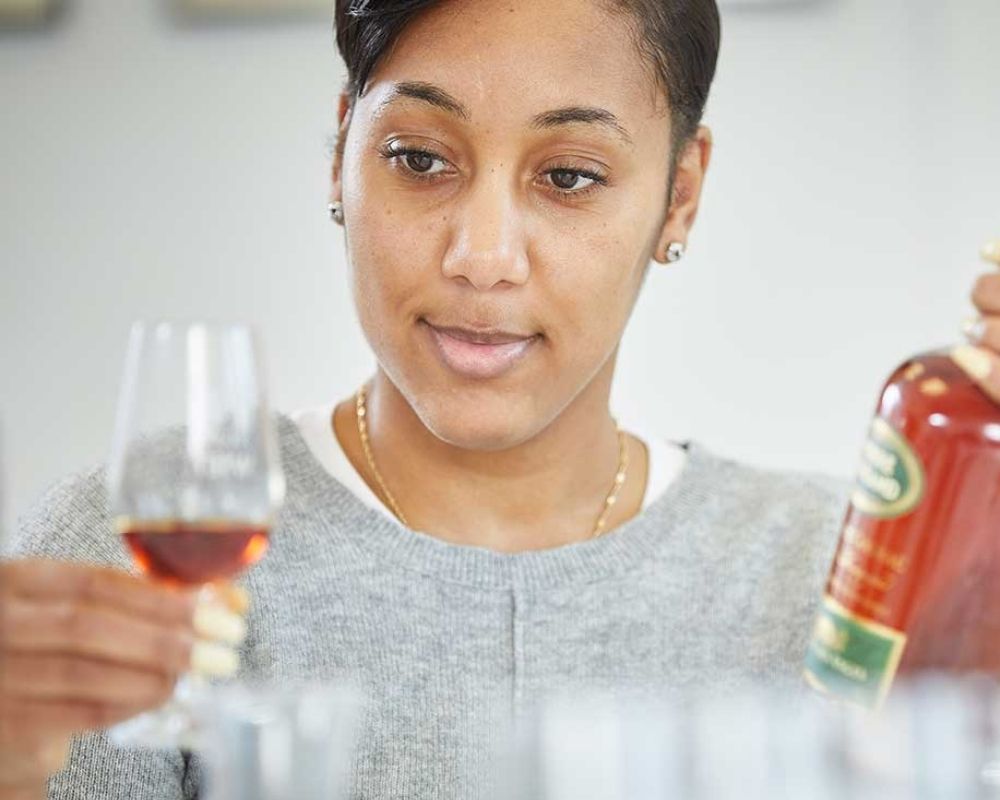
4. How to Taste Rum Like a Pro with WSET’s SAT Method
Tasting rum is both an art and a science, and you can master it with the right method.
In WSET Spirits courses, you learn how to taste using the SAT (Systematic Approach to Tasting) — a globally recognized, professional tasting technique.
4.1. Key Steps in the WSET Tasting Method
The SAT breaks tasting down into four key stages:
1. Appearance
- Clarity: Clear, hazy…
- Intensity: Pale, medium, deep.
- Color: Colorless, lemon, amber, copper, mahogany (often linked to age and barrel maturation).
- Legs: Indicating alcohol and sugar content.
2. Nose
- Condition: Clean, no faults.
- Aromatic intensity: Light, medium, pronounced.
- Typical aromas:
- Fruits: Banana, pineapple, plum, candied citrus.
- Vegetal: Fresh cane, herbs, spices.
- Spices: Vanilla, cinnamon, clove.
- Oak: Toasted wood, caramel, coffee, chocolate.
- Others: Leather, tobacco, molasses, smoky notes.
3. Palate
- Sweetness: Dry, off-dry, sweet.
- Alcohol: Balance, warmth.
- Body: Light, medium, full.
- Texture: Silky, oily, creamy.
- Flavors: Consistent with nose or revealing new dimensions.
- Finish: Short, medium, long — considering intensity and complexity.
4. Conclusion
- Quality level: Poor, acceptable, good, very good, outstanding.
- Aging potential: Drink now or suitable for further aging.
👉 You can find the full WSET Spirits SAT tasting sheets on the official WSET website.
4.2. Why Use This Method?
- Build a precise sensory vocabulary.
- Improve your ability to recognize different rum styles.
- Confidently advise clients or enthusiasts.
- Structure your critical thinking and avoid subjective bias.
- Succeed in the tasting section of your WSET exams.
4.3. Our Best Tasting Tips
- Always use a tulip-shaped glass.
- Take your time; let the rum open up.
- Regularly taste different styles to expand your palate.
4.4. The Importance of Practice
WSET Spirits students taste a wide variety of iconic rums during their training at Weeno — including agricole, Jamaican, Cuban, aged, and overproof rums.
Each tasting session refines your palate and deepens your understanding of global rum styles.
👉 Want to practice like a pro?
Check out our tasting kits designed for WSET online courses.
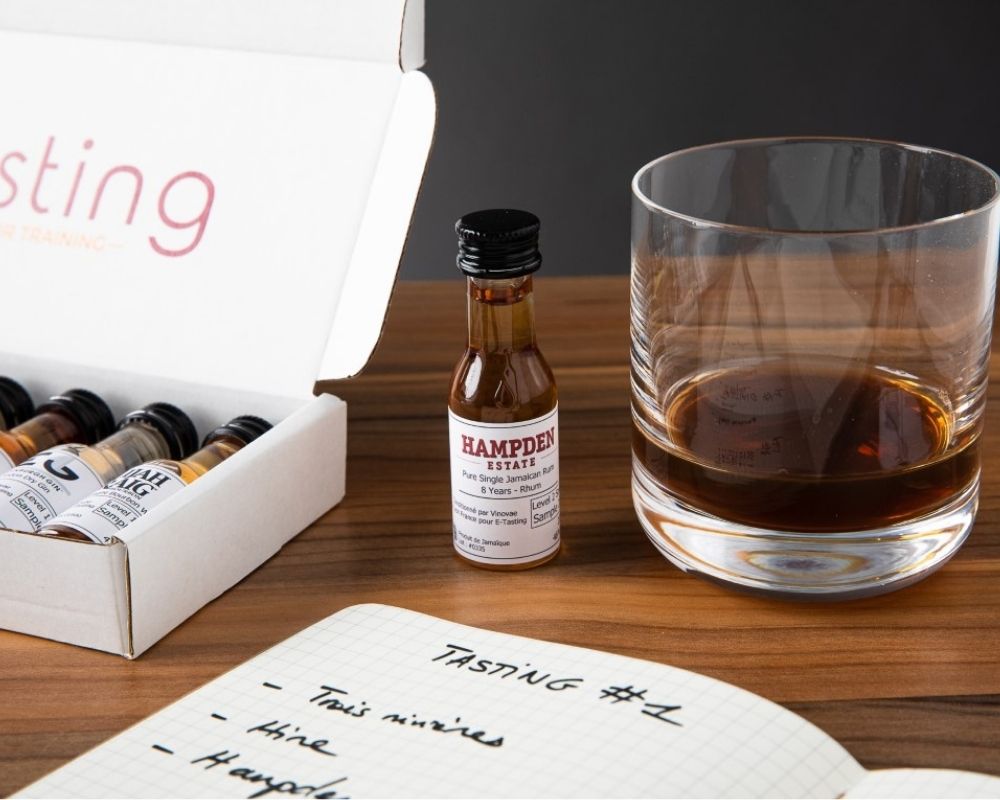
5. Perfect Food and Rum Pairings: Elevate Every Tasting Experience
Rum is an incredibly versatile spirit that pairs beautifully with a wide variety of dishes thanks to its diverse styles.
By playing with flavors, textures, and intensities, you can create memorable and harmonious tasting experiences.
In WSET Spirits courses, you’ll learn the fundamentals of food and spirit pairing — principles that apply perfectly to rum.
5.1. Key Principles for Pairing Rum and Food
- Complementary Pairings: Match similar flavors (sweet with sweet, spicy with spicy).
- Contrasting Pairings: Balance opposite profiles (sweet with salty, rich with acidic).
- Intensity Matching: Make sure the rum and the dish are equally intense. A bold rum requires a rich dish.
- Balance Alcohol / Sweetness / Spice: Be cautious — alcohol can intensify heat or bitterness.
5.2. Rum Pairing Ideas by Style
Rum pairs wonderfully with:
- Dark chocolate: aged rums, rich and full-bodied.
- Tropical fruits: white rums, especially agricole styles.
- Caramelized desserts: amber rums.
- Bold cheeses: spiced or high-proof rums.
5.3. Pro WSET Tip: Test and Adjust!
The perfect pairing always depends on your own palate.
Don’t hesitate to experiment, take notes, and fine-tune your combinations.
The WSET approach helps you understand why some pairings work — and how to tweak the details for an even better match.

6. Why Study Rum with WSET at Weeno?
WSET Spirits qualifications help you:
- Build deep, structured knowledge of spirits.
- Master professional tasting techniques.
- Gain a globally recognized certification in over 70 countries.
- Boost your confidence and advance your career.
Weeno is an accredited WSET provider, known for its quality teaching, practical resources, and high success rates (100% pass rate for WSET Level 2 Spirits in 2024).
Here’s what sets us apart:
- Expert Educators: Industry professionals with years of experience make technical concepts accessible and exciting. Our instructors have been teaching at Weeno for over 4 years and bring passion and expertise to every class.
- High-Quality Tasting Samples: A curated selection of mostly artisanal spirits helps sharpen your palate and prepare you thoroughly for the exam.
- Personalized Support: Access to exclusive resources, quizzes, revision guides, and tailored guidance in small groups of no more than 10 students.
- A Warm, Supportive Learning Environment: Whether in Paris (9th arrondissement) or online, your learning takes place in a friendly and intimate setting.
- Eligible for CPF Funding: Our bilingual (French-English) or fully English WSET programs can be funded through the French CPF scheme under the CLOE certification in English. A direct link to apply is provided on our course pages.
And best of all — you can train in Paris, Marseille, or 100% online, at your own pace, with tasting kits, interactive quizzes, and access to an international learning community.
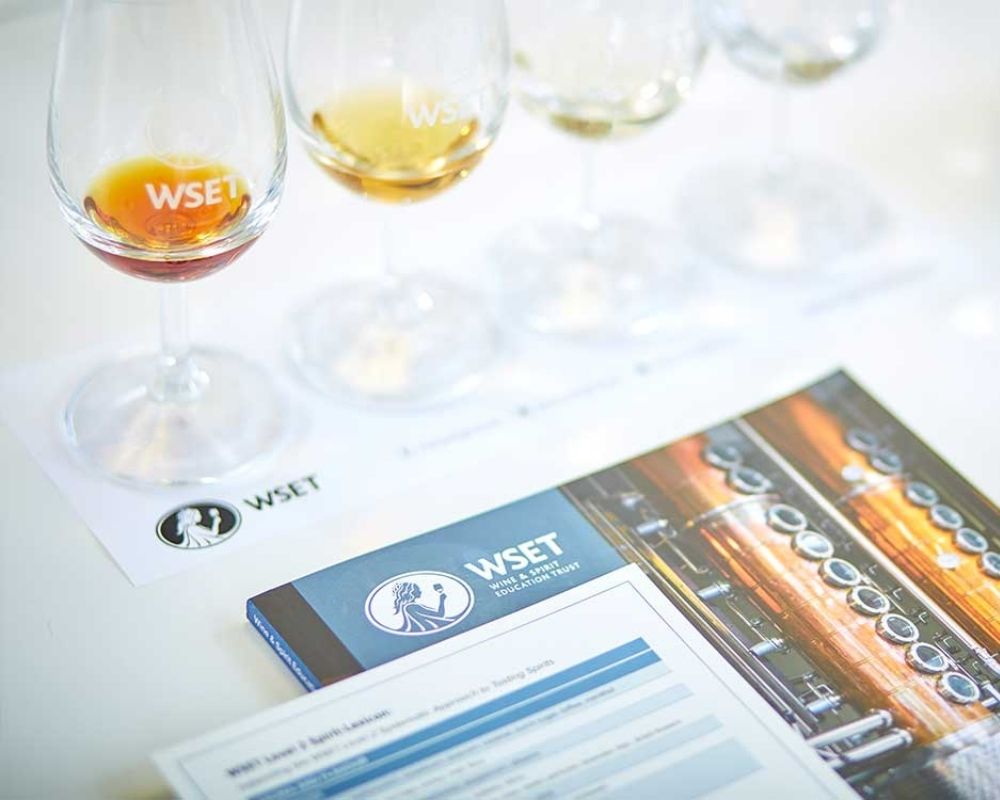
Conclusion: Rum — A World to Explore and Master
Rum is far more than just a tropical spirit.
Its rich aromas, broad stylistic range, and cultural heritage make it a fascinating product to discover and understand in depth.
Whether you’re a passionate enthusiast or a beverage industry professional, mastering rum can elevate your tasting skills, broaden your knowledge, and strengthen your credibility.
To truly appreciate and speak confidently about rum, nothing compares to the structured learning experience of a WSET Spirits qualification.
👉 With WSET Spirits courses at Weeno, you’ll learn how to:
- Identify rum styles with precision.
- Understand how production, origin, and technique impact quality.
- Taste like a pro with the WSET SAT method.
- Build unforgettable rum & food pairings.
- Earn a globally recognized certification — 100% accessible online or in person.
🎓 Ready to dive into the world of rum with structure and passion?
Explore our WSET Spirits courses (Levels 1, 2 or 3) in-person or online and book your session now at weenodrinksacademy.com



